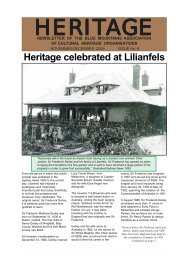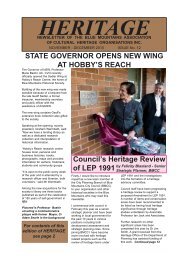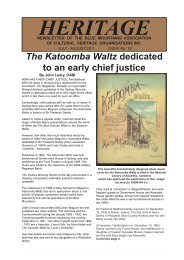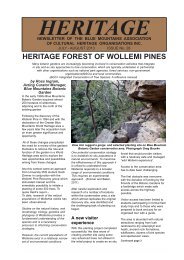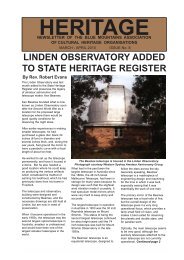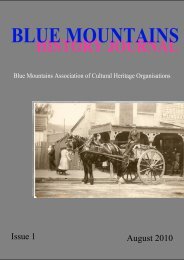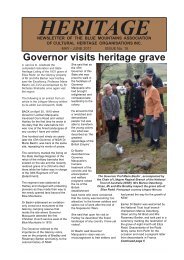Blue Mountains History Journal Issue 3
Blue Mountains History Journal Issue 3
Blue Mountains History Journal Issue 3
Create successful ePaper yourself
Turn your PDF publications into a flip-book with our unique Google optimized e-Paper software.
<strong>Blue</strong> <strong>Mountains</strong> <strong>History</strong> <strong>Journal</strong> 3: 2012<br />
Nevertheless, Taylor’s <strong>Blue</strong> Plateau was more extensive than David’s plateau. It extended to cover all the<br />
elevated sandstone from around the Nattai in the south to the Hunter in the north. In 1958 he claimed that<br />
for many years he had<br />
“... endeavoured to get the public to use the term <strong>Blue</strong> Plateau for this wide extent of Hawkesbury<br />
Sandstone.” (Taylor 1958, p.99).<br />
The fact that some still argued for a relatively expansive <strong>Blue</strong> <strong>Mountains</strong> upset the writers of the first<br />
Australian Encyclopaedia, who stated:<br />
“The name ‘<strong>Blue</strong> <strong>Mountains</strong>’ is often used in a vague and erroneous way to denote the whole main<br />
range region west of Sydney; thus the Jenolan caves (q.v.) are said to lie ‘in the heart of the <strong>Blue</strong><br />
<strong>Mountains</strong>,’ though they are at least 25 miles from their nearest edge. The name is properly applied<br />
only to the sandstone plateau bounded on the north by the Capertee and Colo rivers, and on the south<br />
and west by the Cox; the Kurrajong Ridge, though a part of this plateau, is usually considered a<br />
separate area.” (Jose & Carter 1925, p.177).<br />
This was to rile Myles Dunphy, with justification. The broader definition may well have been vague, but<br />
not erroneous. It could certainly be claimed that Jenolan Caves lies within the <strong>Blue</strong> <strong>Mountains</strong> (Dunphy<br />
1969, p.23).<br />
Other publications took a similar view to the Encyclopaedia. For instance, from 1897 “The<br />
Mountaineer” newspaper published the “Illustrated Tourists’ Guide to the <strong>Blue</strong> <strong>Mountains</strong> and Jenolan<br />
Caves” implying that Jenolan Caves was outside the <strong>Blue</strong> <strong>Mountains</strong> (Mountaineer 1897-8).<br />
The second Australian Encyclopaedia, which appeared in 1958, was less dogmatic than the first, but<br />
nonetheless stuck to the localised definition:<br />
“... an ill-defined region which may be taken to embrace the country bounded by the Cox River on the<br />
west and south and the lower Nepean and Hawkesbury on the east, and extending north roughly to the<br />
latitude of Lithgow.” (Chisholm 1958, p.37, col.2.).<br />
The Greater <strong>Blue</strong> <strong>Mountains</strong>?<br />
Myles Dunphy drew many bushwalking maps, especially of what he called the Southern <strong>Blue</strong> <strong>Mountains</strong><br />
— the country generally between Katoomba, Jenolan Caves and Yerranderie. The Lands Department’s<br />
<strong>Blue</strong> <strong>Mountains</strong> and Burragorang Tourist Map, which ran to many editions from 1932, was prepared at<br />
Dunphy’s persuasion and with much of his input. It covers from Lidsdale and Mount Tootie in the north,<br />
down to Taralga and Moss Vale in the south, thereby implying that the mountains were more extensive<br />
than many would have supposed, though no actual boundaries of the <strong>Blue</strong> <strong>Mountains</strong> were supplied (NSW<br />
Department of Lands 1932).<br />
Dunphy was well aware of the early history of the name and believed it should be applied in the<br />
expansive sense. Accordingly, when in 1932 he and his National Parks and Primitive Areas Council<br />
formally proposed a huge national park covering almost to the Hunter Range in the north, and almost to<br />
Wombeyan Caves road in the south, he simply called it a “<strong>Blue</strong> <strong>Mountains</strong> National Park” (Dunphy<br />
1934). (Figure 6).<br />
However, he was also aware of the contradictory definitions that had taken hold, believing the name had<br />
been hijacked by parochial tourism interests. He came to realise that if his vision was to be realised he<br />
would need<br />
“... to by-pass the political, local government and mountain tourist interests and so avoid an argument<br />
… as to the limits of the <strong>Blue</strong> <strong>Mountains</strong>.” (Dunphy 1969, p.39).<br />
Accordingly, he gradually introduced the word ‘Greater’. In an 1934 item titled <strong>Blue</strong> <strong>Mountains</strong> National<br />
Park Scheme, he stated:<br />
13




